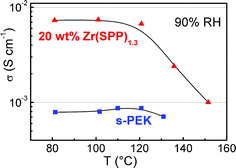Amorphous zirconium phosphate sulfophenylenphosphonates (Zr(HPO4)2−x(SPP)x, where SPP = O3PC6H4SO3H and 0.5 ≤
x
≤ 1.3) were precipitated from solutions of zirconyl chloride, H3PO4 and H2SPP and characterised by thermogravimetric analysis, solid state NMR and impedance measurements. Zr(HPO4)0.7(SPP)1.3 showed the highest proton conductivity (0.07 S cm−1 at 20 °C, 90% relative humidity) and turned out to be suitable to form a gel in dimethylformamide (DMF) containing about 7 wt% solid phase. The gel was used to prepare composite membranes of sulfonated polyetherketone (I. E. C. = 0.95 meq g−1) filled with 10 and 20 wt% Zr(HPO4)0.7(SPP)1.3. SEM pictures showed that the composite membranes are dense and homogeneous with filler particles not larger than 200 nm. The proton conductivity of both composite membranes and that of a pure s-PEK membrane was determined as a function of temperature up to 150 °C, at 90% relative humidity, by means of the impedance technique. While the conductivity of the s-PEK membrane was nearly constant within the overall temperature range (7–9 × 10−4 S cm−1), the conductivity of the composite membranes was independent of temperature up to 110 °C but at higher temperatures it decreased to a value approaching the conductivity of s-PEK. In the range 80–110 °C, the conductivity of the composite membrane with 20 wt% Zr(HPO4)0.7(SPP)1.3 was around 8 × 10−3 S cm−1. The possibility that the increase of conductivity arises from the presence of filler rich and/or filler continuous conduction pathways is discussed.

You have access to this article
 Please wait while we load your content...
Something went wrong. Try again?
Please wait while we load your content...
Something went wrong. Try again?


 Please wait while we load your content...
Please wait while we load your content...